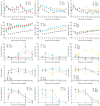Effect of neuraminidase inhibitor-resistant mutations on pathogenicity of clade 2.2 A/Turkey/15/06 (H5N1) influenza virus in ferrets
- PMID: 20523902
- PMCID: PMC2877746
- DOI: 10.1371/journal.ppat.1000933
Effect of neuraminidase inhibitor-resistant mutations on pathogenicity of clade 2.2 A/Turkey/15/06 (H5N1) influenza virus in ferrets
Abstract
The acquisition of neuraminidase (NA) inhibitor resistance by H5N1 influenza viruses has serious clinical implications, as this class of drugs can be an essential component of pandemic control measures. The continuous evolution of the highly pathogenic H5N1 influenza viruses results in the emergence of natural NA gene variations whose impact on viral fitness and NA inhibitor susceptibility are poorly defined. We generated seven genetically stable recombinant clade 2.2 A/Turkey/15/06-like (H5N1) influenza viruses carrying NA mutations located either in the framework residues (E119A, H274Y, N294S) or in close proximity to the NA enzyme active site (V116A, I117V, K150N, Y252H). NA enzyme inhibition assays showed that NA mutations at positions 116, 117, 274, and 294 reduced susceptibility to oseltamivir carboxylate (IC(50)s increased 5- to 940-fold). Importantly, the E119A NA mutation (previously reported to confer resistance in the N2 NA subtype) was stable in the clade 2.2 H5N1 virus background and induced cross-resistance to oseltamivir carboxylate and zanamivir. We demonstrated that Y252H NA mutation contributed for decreased susceptibility of clade 2.2 H5N1 viruses to oseltamivir carboxylate as compared to clade 1 viruses. The enzyme kinetic parameters (V(max), K(m) and K(i)) of the avian-like N1 NA glycoproteins were highly consistent with their IC(50) values. None of the recombinant H5N1 viruses had attenuated virulence in ferrets inoculated with 10(6) EID(50) dose. Most infected ferrets showed mild clinical disease signs that differed in duration. However, H5N1 viruses carrying the E119A or the N294S NA mutation were lethal to 1 of 3 inoculated animals and were associated with significantly higher virus titers (P<0.01) and inflammation in the lungs compared to the wild-type virus. Our results suggest that highly pathogenic H5N1 variants carrying mutations within the NA active site that decrease susceptibility to NA inhibitors may possess increased virulence in mammalian hosts compared to drug-sensitive viruses. There is a need for novel anti-influenza drugs that target different virus/host factors and can limit the emergence of resistance.
Conflict of interest statement
The authors declare no competing financial interests. While the study reported here did not utilize corporate funding, Drs. Natalia A. Ilyushina, Elena A. Govorkova, and Robert G. Webster are currently performing a different research study funded by F. Hoffmann-LaRoche, Ltd., Basel, Switzerland. In addition, the NA inhibitors oseltamivir carboxylate and zanamivir were provided by Hoffmann-La Roche, Ltd. (Basel, Switzerland).
Figures




References
-
- World Health Organization. 2010. Cumulative number of confirmed human cases of avian influenza A/(H5N1) reported to WHO. World Health Organization. Available: http://www.who.int/csr/disease/avian_influenza/country/cases_table_2010_.... Accessed March 8 2010.
-
- Webster RG, Govorkova EA. H5N1 influenza – continuing evolution and spread. N Engl J Med. 2006;355:2174–2177. - PubMed
-
- Abdel-Ghafar AN, Chotpitayasunondh T, Gao Z, Hayden FG, Nguyen DH, et al. Update on avian influenza A (H5N1) virus infection in humans. N Engl J Med. 2008;358:261–273. - PubMed
-
- Moscona A. Medical management of influenza infection. Annul Rev Med. 2008;59:397–413. - PubMed
Publication types
MeSH terms
Substances
Grants and funding
LinkOut - more resources
Full Text Sources
Other Literature Sources
Medical

